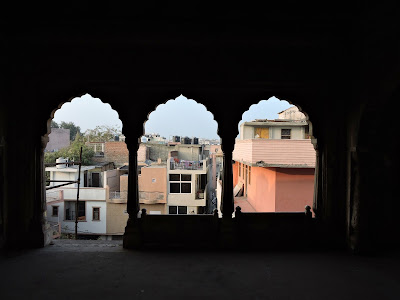A few weeks ago, my friend goaded me to go out, get some pictures. It was already about noon, so I headed for the Zafar Mahal at Mehrauli, which is not too far away and I could not visit this monument earlier.
We took the walkway through the Mehrauli Archaeological Park, keeping the mosque of Kamali Jamali and the other buildings to the right and came across Rajon Ki Baoli to the left, one of the few remaining baolis or stepped wells in Delhi. There was also a small mosque on the top right hand side on the western wall
 |
| Rajon Ki Baoli |
We also came across some new excavations and conservation efforts being carried out by the ASI, a gallery, an unknown tomb probably dating back to the Lodhi period and gatehouses.
Also noticed a lone sparrowhawk enjoying the sun ...
More tombs and pavilions in ancient graveyards along the way, perhaps of powerful noblemen during the Sultanate period whom nobody remembers these days. The ego of men!
 |
| An unknown tomb |
 |
| Gandhak Baoli, Mehrauli |
The Zafar Mahal is the last palace built by the later Mughals and the last Mughal emperor Bahadur Shah Zafar installed the gateway to the building. He also lived in this building during the summer season. It is said that people used to salute him when he appeared on the balconies which was not liked by the East India Company, so they diverted the Mehrauli Badarpur road which used to run in front of the building.
We climbed some stairs to get to the top. Some other stairs end abruptly and some areas are quite perilous so they have a guard in place. So these were the rooms of the last Mughal emperor, before he was caught up with the Mutiny and was exiled to Rangoon by the East India Company
There is also a lovely little marble mosque attached to these premises, the Moti Masjid like that in the Red Fort. Between the Zafar Mahal and the Moti Masjid is a small yard containing the tombs of three later Mughals and alongside, an empty space where Zafar Shah would have liked himself to be buried, but for fate which denied him the two yards of earth in his beloved homeland
The dargah of the venerable sufi saint Qutbuddin Bakhtiyar Kaki is next door, actually. While you can enter from the Zafar Mahal side, the main entrance is from the Mehrauli village. That shoe rack to the right is where I left my shoes. Washed my hands. Bought a tray of rose petals to offer to the saint.
Made some small donations for charity, bowed my head to the saint and poured a handful of rose petals on his grave, wondering what he said to the masses that gathered to hear him everyday. Including the Sultan, incognito.
And there are those who sing qawwalis everyday outside the main enclosure, bless them, for the saint was very fond of qawwali music. He also led an extremely austere life, giving away whatever was offered to him the same day.
Lovers don't finally meet somewhere,
They're in each other all along.
(Jalaluddin Rumi)




























You have so much architectural history in India!
ReplyDeleteI enjoy seeing your palaces and tombs, but the stepped wells are particularly interesting to me. These ancient reservoirs/baths are so intricate, elaborate and stunning. The ugly, gaping hole-in-the-ground reservoirs here in the western United States are quite primitive in comparison.
Thanks for this interesting and informative post, Soumyendu!
As you have rightly pointed out, Rita, these stepped wells had a set of surrounding rooms and corridors for use of the nobility of the period. There is another stepped well in Delhi which is also known to be haunted! And this one too, had a security guard watching us and as we were coming back, the gates were wrapped secure by locks and chains :)
DeleteThank you Rita
A haunted stepped well—perfect for a Halloween blog posting!
Delete